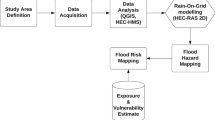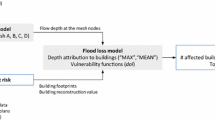Abstract
The paper presents a consistent micro-scale flood risk analysis procedure, relying on detailed 2D inundation modelling as well as on high resolution topographic and land use database. The flow model is based on the shallow-water equations, solved by means of a finite volume scheme on multi-block structured grids. Using highly accurate laser altimetry, the simulations are performed with a typical grid spacing of 2 m, which is fine enough to represent the flow at the scale of individual buildings. Consequently, the outcomes of hydraulic modelling constitute suitable inputs for the subsequent exposure analysis, performed at a micro-scale using detailed land use maps and geographic database. Eventually, the procedure incorporates social flood impact analysis and evaluation of direct economic damage to residential buildings. Besides detailing the characteristics and performance of the hydraulic model, the paper describes the flow of data within the overall flood risk analysis procedure and demonstrates its applicability by means of a case study, for which two different flood protection measures were evaluated.

























Similar content being viewed by others
References
Apel H, Aronica G, Kreibich H, Thieken A (2007) Flood risk assessment strategies—a comparative study. Geophys Res Abstr 9:02916
Apel H, Aronica G, Kreibich H, Thieken A (2009) Flood risk analyses—how detailed do we need to be? Nat Hazards 49(1):79–98
Bates PD, de Roo APJ (2000) A simple raster-based model for flood inundation simulation. J Hydrol 236:54–77
Begnudelli L, Sanders BF, Bradford SF (2008) Adaptive Godunov-Based model for flood simulation. J Hydraul Eng 134(6):714–725
Boquet A (2009) Contributions à l’analyse du risque d’inondation : probabilité de rupture de barrage et enquête de validation de dommages, University of Liège, 74
Bradbrook K, Waller S, Morris D (2005) National floodplain mapping: datasets and methods—160,000 km in 12 months. Nat Hazards 36(1):103–123
Brouwer R, Akter S, Brander L, Haque E (2007) Socioeconomic vulnerability and adaptation to environmental risk: a case study of climate change and flooding in Bangladesh. Risk Anal 27(2):313–326
Caleffi V, Valiani A, Zanni A (2003) Finite volume method for simulating extreme flood events in natural channels. J Hydraul Eng-ASCE 41(2):167–177
Chaudhry MH (1993) Open-channel flow. Englewood Cliffs, Prentice Hall
Coninx I (2008) Social flood risk assessment—methodological paper for the ADAPT project. Leuven, KUL, 25
Coninx I, Bachus K (2007) Integrating social vulnerability to floods in a climate change context. In: Proc. int. conf. on adaptive and integrated water management, coping with complexity and uncertainty, Basel, Switzerland
de Wit MJM, Peeters HA, Gastaud PH, Dewil P, Maeghe K, Baumgart J (2007) Floods in the Meuse basin: event descriptions and an international view on ongoing measures. Int J River Basin Manage 5(4):279–292
Dewals BJ, Erpicum S, Archambeau P, Detrembleur S, Pirotton M (2006a) Depth-integrated flow modelling taking into account bottom curvature. J Hydraul Res 44(6):787–795
Dewals BJ, Erpicum S, Archambeau P, Detrembleur S, Pirotton M (2006b) Numerical tools for dam break risk assessment: validation and application to a large complex of dams. In: Hewlett H (ed) Improvements in reservoir construction, operation and maintenance. Thomas Telford, London, pp 272–282
Dewals BJ, Detrembleur S, Archambeau P, Erpicum S, Pirotton M (2008a) Detailed 2D hydrodynamic simulations as an onset for evaluating socio-economic impacts of floods considering climate change. In: Samuels P, Huntington S, Allsop W, Harrop J (eds) Flood risk management: research and practice. Taylor & Francis, London, pp 125–135
Dewals BJ, Giron E, Ernst J, Hecq W, Pirotton M (2008b) Integrated assessment of flood protection measures in the context of climate change: hydraulic modelling and economic approach. In: K Aravossis, CA Brebbia, N Gomez (eds) Environmental economics. WIT press, Southampton, UK, p 10
Dewals BJ, Kantoush SA, Erpicum S, Pirotton M, Schleiss AJ (2008c) Experimental and numerical analysis of flow instabilities in rectangular shallow basins. Environ Fluid Mech 8:31–54
Dushmanta D, Srikantha H, Katumi M (2003) A mathematical model for flood loss estimation. J Hydrol 277:24–49
Ernst J, Dewals BJ, Detrembleur S, Archambeau P, Erpicum S, Pirotton M (2008a) Integration of accurate 2D inundation modelling, vector land use database and economic damage evaluation. In: Samuels P, Huntington S, Allsop W, Harrop J (eds) Flood risk management: research and practice. Taylor & Francis, London, pp 1643–1653
Ernst J, Dewals BJ, Giron E, Hecq W, Pirotton M (2008b) Integrating hydraulic and economic analysis for selecting flood protection measures in the context of climate change. In: Proc. 4th int. symp. on flood defence, Toronto, Canada, Institute for Catastrophic Loss Reduction
Ernst J, Coninx I, Dewals BJ, Detrembleur S, Erpicum S, Bachus K, Pirotton M (2009a) Social flood impacts in urban areas: integration of detailed flow modelling and social analysis. In: Proc. 33rd IAHR congress—water engineering for a sustainable environment. Vancouver, British Columbia, IAHR
Ernst J, Coninx I, Dewals BJ, Detrembleur S, Erpicum S, Pirotton M, Bachus K (2009b) Planning flood risk reducing measures based on combined hydraulic simulations and socio-economic modelling at a micro-scale. In: Proc. European water resources association 7th int. conf.—water resources conservation and risk reduction under climatic instability, Limassol, Cyprus
Erpicum S, Archambeau P, Detrembleur S, Dewals B, Pirotton M (2007) A 2D finite volume multiblock flow solver applied to flood extension forecasting. In: García-Navarro P, Playán E (eds) Numerical modelling of hydrodynamics for water ressources. Taylor & Francis, Londres, pp 321–325
Erpicum S, Dewals BJ, Archambeau P, Pirotton M (2009a) Dam-break flow computation based on an efficient flux-vector splitting. J. Comput Appl Math (in press). doi:10.1016/j.cam.2009.08.110
Erpicum S, Meile T, Dewals BJ, Pirotton M, Schleiss AJ (2009b) 2D numerical flow modeling in a macro-rough channel. Int J Numer Methods Fluids 61(11):1227–1246
Erpicum S, Dewals BJ, Archambeau P, Detrembleur S, Pirotton M (2010) Detailed inundation modeling using high resolution DEMs. Eng Appl Comput Fluid Mech 4(2):196–208
FloodSite (2005) Language of risk 56
Giron E, Coninx I, Dewals BJ, El Kahloun M, De Smet L, Sacré D, Detrembleur S, Bachus K, Pirotton M, Meire P, De Sutter R, Hecq W (2009). Towards an integrated decision tool for adaptation measures—case study: floods. « ADAPT » Final Report Phase 1. Brussels, Belgian Science Policy, 122
Hervouet J-M (2003) Hydrodynamique des écoulements à surface libre—Modélisation numérique avec la méthode des éléments finis. Paris, Presses de l’école nationale des Ponts et Chaussées
ICPR (2001) Rhine atlas International Commission for the Protection of the Rhine
IPCC (2007) Climate change 2007: Synthesis Report—Summary for policymakers. Intergovernmental Panel on Climate Change
Kaplan S, Garrick BJ (1981) On the quantitative definition of risk. Risk Anal 1(1):11–27
Kreibich H, Müller M, Thieken AH, Merz B (2007) Flood precaution of companies and their ability to cope with the flood in August 2002 in Saxony, Germany. Water Resour Res 43(W03408). doi:10.1029/2005WR004691
McMillan HK, Brasington J (2007) Reduced complexity strategies for modelling urban floodplain inundation. Geomorphology 90(3–4):226–243
McMillan HK, Brasington J (2008) End-to-end risk assessment: a coupled model cascade with uncertainty estimation. Water Resour Res 44(W03419):14
Merz B, Kreibich H, Thieken A, Schmidtke R (2004) Estimation uncertainty of direct monetary flood damage to buildings. Nat Hazards Earth Syst Sci 4(1):153–163
Mignot E, Paquier A, Haider S (2006) Modeling floods in a dense urban area using 2D shallow water equations. J Hydrol 327(1–2):186–199
Penning-Rowsell EC, Johnson C, Tunstall SM, Tapsell SM, Morris J, Chatterton JB, Coker A, Green C (2003) The benefits of flood and coastal defence: techniques and data for 2003. Flood Hazard Research Centre, Middlesex University
Roger S, Dewals BJ, Erpicum S, Pirotton M, Schwanenberg D, Schüttrumpf H, Köngeter J (2009) Experimental und numerical investigations of dike-break induced flows. J Hydraul Res 47(3):349–359
Smith DI (1994) Flood damage estimation—a review of urban stage damage curves and loss function. Water SA 20(3):231–238
Thieken AH, Müller M, Kreibich H, Merz B (2005) Flood damage and influencing factors: new insights from the August 2002 flood in Germany. Water Resour Res 41(W12430). doi:10.1029/2005WR004177
Thieken AH, Ackermann V, Elmer F, Kreibich H, Kuhlmann B, Kunert U, Maiwald H, Merz B, Müller M, Piroth K, Schwarz J, Schwarze R, Seifert I, Seifert J (2008) Methods for the evaluation of direct and indirect flood losses. In: Proc. 4th int. symp. on flood defence, Toronto, Canada, Institue for Catastrophic Loss Reduction
Van der Sande CJ, de Jong SM, de Roo APJ (2003) A segmentation and classification approach of IKONOS-2 imagery for land cover mapping to assist flood risk and flood damage assessment. Int J Appl Earth Observ Geoinf 4:217–229
Wu W (2008) Computational river dynamics. Taylor & Francis, London
Acknowledgment
Part of this research was carried out on behalf of the Belgian Science Policy (BELSPO), in the framework of the research program “Science for a Sustainable Development”. The authors also gratefully acknowledge the “Service Public de Wallonie” (SPW) for the Digital Surface Model and other data.
Author information
Authors and Affiliations
Corresponding author
Additional information
J. Ernst, B. J. Dewals have contributed equally to this article.
Rights and permissions
About this article
Cite this article
Ernst, J., Dewals, B.J., Detrembleur, S. et al. Micro-scale flood risk analysis based on detailed 2D hydraulic modelling and high resolution geographic data. Nat Hazards 55, 181–209 (2010). https://doi.org/10.1007/s11069-010-9520-y
Received:
Accepted:
Published:
Issue Date:
DOI: https://doi.org/10.1007/s11069-010-9520-y




